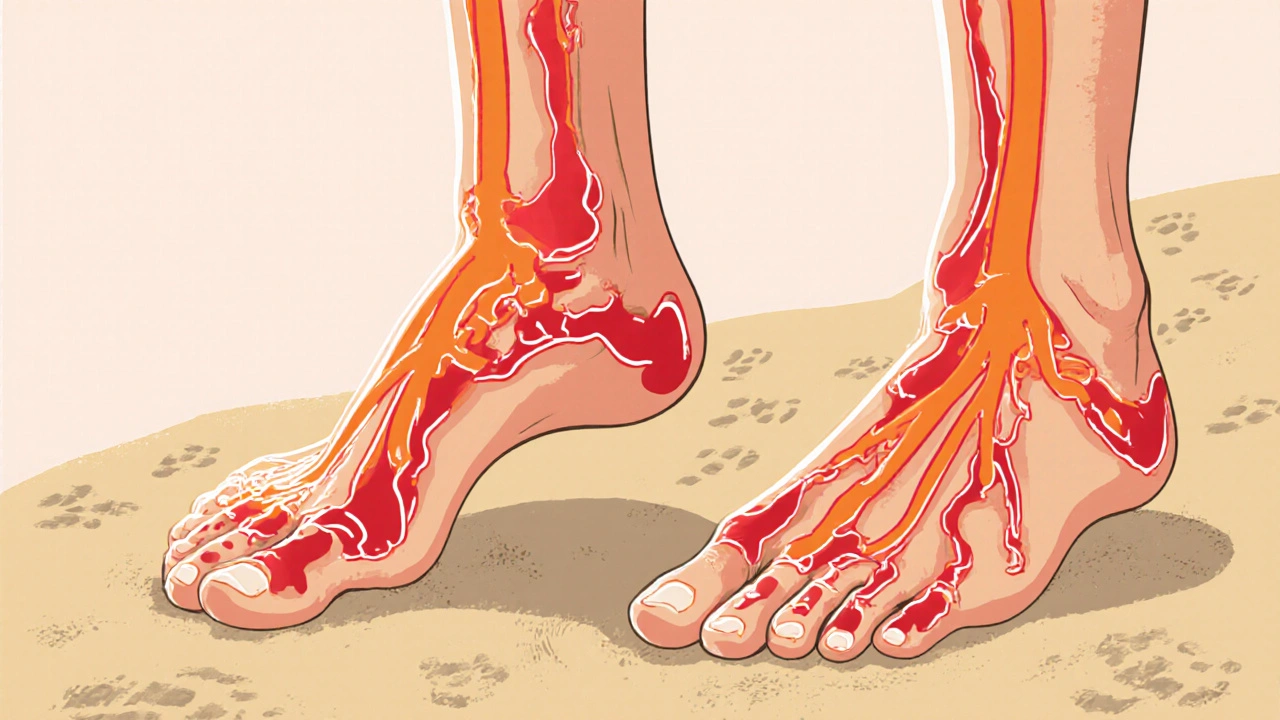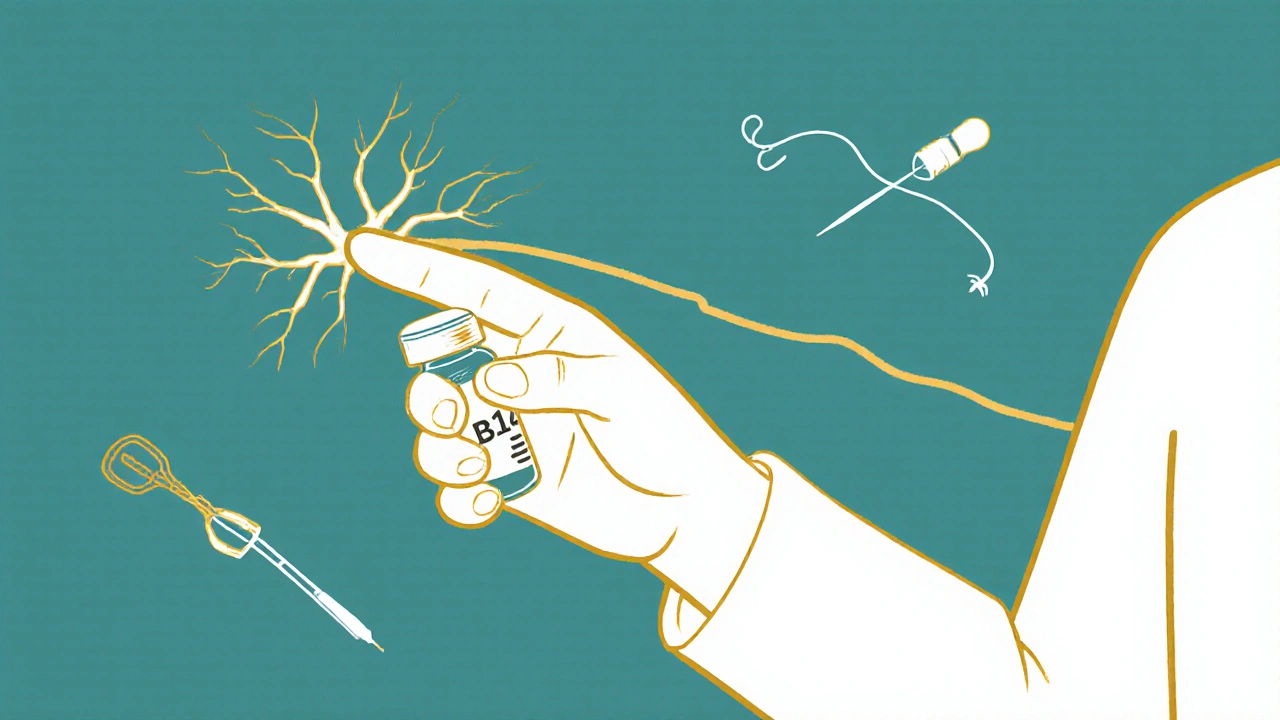Peripheral Neuropathy: Common Causes and Effective Pain Management Strategies

- Colin Hurd
- 13 November 2025
- 15 Comments
When your feet feel like they’re wrapped in sandpaper, or your hands go numb without warning, it’s not just aging-it could be peripheral neuropathy. This isn’t a single disease but a group of conditions where nerves outside your brain and spinal cord get damaged. These nerves control everything from feeling touch to moving your muscles. When they’re hurt, you don’t just get pain-you lose balance, struggle to walk, and sometimes can’t even feel a blister forming on your foot until it’s infected.
What Causes Nerve Damage in Peripheral Neuropathy?
The most common cause? Diabetes. About half of all people with diabetes will develop some form of nerve damage over time. High blood sugar slowly poisons the nerves, especially in the feet and legs. Keeping your HbA1c below 7% cuts your risk of neuropathy by 60%, according to long-term studies like the Diabetes Control and Complications Trial. But diabetes isn’t the only culprit.
Vitamin B12 deficiency is another major player. It affects up to 8% of cases, especially in older adults or people on long-term acid reflux meds like proton pump inhibitors. Without enough B12, nerves can’t repair themselves. That’s why some people feel better within weeks of starting B12 shots-1,000 mcg injected once a week for a month, then monthly.
Chemotherapy is another silent offender. Around 30 to 40% of cancer patients on drugs like vincristine or paclitaxel develop nerve damage. It often starts as tingling in the fingers or toes and can linger long after treatment ends. Some newer chemo drugs are less neurotoxic, but for many, the damage is unavoidable.
Other causes include alcohol abuse, autoimmune diseases like lupus or rheumatoid arthritis, infections such as shingles or Lyme disease, and even certain inherited disorders. In about 20% of cases, doctors can’t find a clear cause-these are called idiopathic neuropathies. Even then, symptoms still need managing.
How Do You Know It’s Neuropathy and Not Just Numbness?
Neuropathy doesn’t just make you feel weird-it follows a pattern. Symptoms usually start in your toes or fingertips and creep upward. You might feel burning, stabbing, or electric shock-like pain. Or you might feel nothing at all-a loss of sensation that’s just as dangerous.
Doctors use simple tests to confirm it. A 10-gram monofilament pressed against your foot checks for loss of touch. A 128-Hz tuning fork tests vibration sense. If you can’t feel either, nerve damage is likely. Nerve conduction studies measure how fast signals travel through your nerves. Normal speed is above 50 meters per second; below 40? That’s a red flag.
Many people wait months-or even years-before getting tested. The average time from first symptom to diagnosis is 18 months. By then, nerves may already be permanently damaged. If you’ve had unexplained numbness, tingling, or pain in your hands or feet for more than a few weeks, don’t wait. Get checked.
Medications That Actually Work for Neuropathy Pain
Over-the-counter painkillers like ibuprofen or acetaminophen? They barely help. Neuropathic pain doesn’t respond to regular anti-inflammatories. You need targeted meds.
Pregabalin (Lyrica) is one of the most prescribed. It reduces pain by 50% in about 37% of users. But it comes with side effects: dizziness, weight gain, and brain fog. Many people stop taking it because they feel too spaced out.
Duloxetine (Cymbalta), an antidepressant, works for about 35% of people. It helps with both pain and depression, which often go hand-in-hand with chronic pain. But nausea is common-some users quit after just two weeks because they couldn’t keep food down.
Amitriptyline, an older tricyclic antidepressant, is cheaper and effective for 41% of patients. But it dries your mouth, makes you sleepy, and can mess with your heart rhythm if you’re over 65. It’s not for everyone, but for those who tolerate it, it’s a game-changer.
None of these are magic bullets. About 65% of people stop their meds within three months because of side effects. That’s why doctors now recommend starting low and going slow. A 10-mg dose of amitriptyline at night might be enough to help sleep and ease pain without wrecking your day.

Non-Drug Treatments That Make a Real Difference
If pills aren’t working-or you don’t want to take them-there are other options.
Scrambler therapy is one of the most surprising. It uses mild electrical pulses to “trick” your brain into thinking it’s not in pain. After 10 sessions, 85% of patients report at least 50% pain reduction. The catch? It costs $1,200 to $1,500 per full course and isn’t covered by all insurance.
Spinal cord stimulation is another high-tech fix. A tiny device is implanted near your spine and sends gentle pulses to block pain signals. It works for 65% of people who’ve tried everything else. It’s invasive and expensive, but for those with severe, unrelenting pain, it’s life-changing.
Physical therapy is underrated. Simple balance exercises-standing on one foot, heel-to-toe walking, chair stands-improve stability by 25% after 12 weeks. That means fewer falls, fewer broken hips. Most therapists recommend two to three sessions a week for at least eight weeks.
Custom orthotics? They’re worth it. People with neuropathy often have foot deformities from muscle weakness. Special shoes or inserts reduce pressure points and prevent ulcers. One NHS survey found 82% of users were satisfied with their custom orthotics after three months.
What You Can Do Every Day to Protect Your Nerves
Managing neuropathy isn’t just about meds or therapy-it’s about daily habits.
If you have diabetes, check your feet twice a day. Look for cuts, blisters, redness, or swelling. Use a mirror if you can’t see the bottom of your feet. Wash them daily with warm (not hot) water. Dry them thoroughly, especially between the toes. Never go barefoot-even indoors.
Keep your blood sugar steady. That means checking it 4 to 7 times a day if you’re on insulin. Eating consistent carbs, avoiding sugar spikes, and walking after meals all help. SGLT2 inhibitors like empagliflozin, a newer class of diabetes meds, may reduce neuropathy risk by 30%.
Stop smoking. Nicotine cuts blood flow to your nerves, making damage worse. Cut back on alcohol. Even moderate drinking can accelerate nerve injury.
Supplements? Only if you’re deficient. B12, alpha-lipoic acid, and acetyl-L-carnitine have shown some benefit in studies, but don’t take them without testing your levels first. Too much B6, for example, can actually cause neuropathy.

Why Early Action Matters
One of the biggest mistakes people make is waiting. If you start treatment within the first six months of noticing symptoms, your chances of improvement jump by 40%. Nerves can regenerate-but only if you act fast.
Once nerves die, they’re gone. The goal isn’t to reverse damage you already have-it’s to stop it from getting worse. That’s why controlling diabetes, fixing B12 levels, and avoiding toxins like alcohol or certain chemo drugs is more important than any pill.
And don’t ignore mental health. Chronic pain leads to anxiety and depression. Talking to a counselor, joining a support group like Neuropathy Now, or even connecting with others on Reddit’s r/neuropathy can help you feel less alone.
What’s Next for Neuropathy Treatment?
The future is looking brighter. In 2020, the FDA approved Qutenza-a patch with high-dose capsaicin that you get applied in a doctor’s office. One 30-minute treatment can block pain for up to three months.
Researchers are now testing gene therapies for inherited forms of neuropathy like Charcot-Marie-Tooth. Early trials show nerve signals improving by 20% after six months. AI tools are also being trained to spot early signs of nerve damage from foot scans or wearable sensors, potentially cutting diagnosis time from 18 months to under six.
Wearable nerve stimulators are coming soon. These small devices, worn like a wristband or ankle strap, deliver gentle pulses all day. Early tests show 40% pain reduction. If approved, they could be a game-changer for people who can’t tolerate pills or afford expensive therapies.
By 2030, experts predict combination therapies-drugs that reduce pain while also helping nerves heal-will become standard. That’s the real hope: not just managing pain, but restoring function.
Can peripheral neuropathy be cured?
It depends on the cause. If it’s from a vitamin deficiency, correcting the deficiency can reverse the damage. If it’s from diabetes, tight blood sugar control can stop it from getting worse-and sometimes improve symptoms. But if nerves are already dead, they can’t come back. The goal is to prevent further damage and manage pain.
Is peripheral neuropathy dangerous?
Yes, especially if ignored. Loss of sensation means you might not feel a cut, burn, or blister. That can lead to infections, ulcers, and even amputation. Poor balance increases fall risk, which is a leading cause of injury in older adults. It’s not just about pain-it’s about safety.
Does walking help with neuropathy?
Absolutely. Regular walking improves blood flow to nerves, helps control blood sugar, and strengthens muscles that support balance. Aim for 30 minutes a day, five days a week. Wear supportive shoes. If your feet hurt too much, try water walking or cycling instead.
Why do my neuropathy symptoms get worse at night?
At night, there are fewer distractions. Your brain isn’t busy with daily tasks, so it focuses more on pain signals. Also, body temperature drops slightly, which can make nerve sensitivity worse. Keeping your feet warm and using a bed cradle to keep sheets off your feet can help.
Are there any natural remedies that work?
Some people find relief with capsaicin cream (from chili peppers), acupuncture, or meditation. Alpha-lipoic acid and B vitamins may help if you’re deficient. But don’t rely on supplements alone. Always talk to your doctor-they can test for deficiencies and warn you about interactions.
How long does it take for neuropathy treatment to work?
It varies. B12 shots can improve symptoms in 4 to 8 weeks. Blood sugar control takes 3 to 6 months to show nerve benefits. Medications like pregabalin may help in a few weeks, but full effects can take up to two months. Physical therapy usually shows results after 8 to 12 weeks. Patience is key.
If you’re living with peripheral neuropathy, you’re not alone. Millions deal with this every day. The key is acting early, staying consistent with your plan, and not giving up-even when progress feels slow. Your nerves can’t heal overnight, but with the right approach, you can still live well.




Comments
Nathan Hsu
Man, this post hit home. I’ve been dealing with this for five years now-diabetic neuropathy, feet feel like I’m walking on broken glass. B12 shots? Life-changing. Started at 1,000 mcg weekly, and within a month, the burning stopped. Not cured, but now I can sleep without a heating pad. Also, no more barefoot walking-even in the house. Learned that the hard way. One blister turned into a hospital trip. Don’t wait.
November 14, 2025 AT 04:08
Ashley Durance
Let’s be real-most of these ‘non-drug’ treatments are expensive placebo traps. Scrambler therapy? $1,500 for a 50% reduction? That’s not a treatment, it’s a scam targeting desperate people. And don’t get me started on ‘custom orthotics’-they’re just fancy insoles. If you’re not controlling your blood sugar, nothing else matters. Stop wasting money.
November 14, 2025 AT 20:22
Scott Saleska
I’ve tried everything-Lyrica, Cymbalta, amitriptyline, acupuncture, even CBD oil. Only amitriptyline worked, but I gained 20 pounds and felt like a zombie. The real issue? Doctors don’t listen. I told my neurologist my symptoms started after chemo, and he just handed me a prescription like it was a coupon. Nobody talks about chemo-induced neuropathy enough. It’s not just diabetes. And yes, I’m still numb in my toes after 8 years. No cure. Just damage control.
November 16, 2025 AT 05:23
Ryan Anderson
Just wanted to say thank you for this post 🙏. I’ve been living with idiopathic neuropathy for 3 years, and this is the first time I’ve seen someone explain it without sounding like a textbook. Walking daily helped more than I expected. Also, using a bed cradle? Genius. I didn’t even know that was a thing. My wife found it on Amazon. No more nighttime foot pain. Also, check your HbA1c. Mine was 8.2. Now it’s 6.1. Big difference. You’re not alone 💪
November 18, 2025 AT 01:28
Eleanora Keene
Hi everyone, I just want to encourage you to keep going. I know it feels hopeless sometimes, but small steps matter. I started with 10 minutes of walking a day, then 15, now I do 30. I also started doing balance exercises while brushing my teeth-standing on one foot. It sounds silly, but I haven’t fallen in over a year. And yes, I still have pain-but I’m not letting it win. You’ve got this. And if you need someone to talk to, I’m here. No judgment. 💕
November 18, 2025 AT 14:03
Joe Goodrow
Why are we even talking about this? In my day, people just toughed it out. Back in the 80s, we didn’t have all these fancy pills and gadgets. You worked. You walked. You didn’t whine about numb feet. Now everyone wants a magic fix. Take your meds. Stop drinking. Check your feet. That’s it. No need for $1,500 machines. America’s gone soft.
November 19, 2025 AT 18:22
gent wood
This is one of the most thorough, compassionate, and accurate summaries of peripheral neuropathy I’ve ever read. Thank you. I’ve been in the NHS system for seven years, and I’ve seen too many people dismissed as ‘just getting older.’ The 18-month diagnosis delay is criminal. My doctor didn’t even test me until I lost sensation in my big toe. Please, if you’re reading this and have symptoms-push for a monofilament test. It takes 30 seconds. Don’t let bureaucracy cost you your mobility.
November 20, 2025 AT 20:38
Dilip Patel
Bro i had this for 4 years and my uncle in delhi said its just nerve weakness. he gave me ayurvedic oil and i rubbed it on my feet. it worked. no need for all this science stuff. also why are you taking western medicine? b12 is just vitamin. you can get it from milk and eggs. chill out. also why you so worried about chemo? its for cancer right? you should be happy you alive. just walk barefoot on grass. it cures everything. trust me.
November 21, 2025 AT 11:21
Jane Johnson
Actually, the claim that 60% risk reduction comes from HbA1c below 7% is misleading. The DCCT study cohort was young, healthy, and closely monitored. Real-world diabetics rarely achieve this. Also, the 82% satisfaction rate with orthotics was self-reported, no control group. And scrambler therapy? FDA-cleared, not approved. There’s a difference. Be cautious.
November 21, 2025 AT 21:16
Peter Aultman
Just wanted to say I’ve been walking 30 mins every morning for 6 months. My feet still tingle but I can actually feel my toes now. And I stopped drinking. Not because I was told to, but because I realized I was just using it to numb the pain. Funny how that works. Also, I use a foam roller on my calves. Feels good. No meds. Just movement. It’s not perfect but it’s better than before.
November 23, 2025 AT 17:35
Sean Hwang
My dad has this. He’s 72. Took him 2 years to get diagnosed. Now he does foot checks every night, wears socks to bed, and walks around the block. He says the worst part isn’t the pain-it’s being scared to walk because he might fall. This post got it right. It’s not about curing it. It’s about not letting it take your life. He’s still cooking for us. That’s a win.
November 23, 2025 AT 18:19
Barry Sanders
Let’s be honest-this is just a long ad for pharma companies. Lyrica? Cymbalta? All patent-protected, overpriced, side-effect factories. And now they’re pushing gene therapy like it’s the future? Wake up. The real solution? Stop sugar. Stop alcohol. Stop being lazy. No magic pills. No expensive gadgets. Just discipline. And if you can’t do that? Then stop complaining.
November 24, 2025 AT 12:40
Chris Ashley
Anyone else notice how the post never mentions marijuana? I’ve been using CBD oil for 2 years. My pain’s down 70%. My doc won’t even talk about it. But hey, I’m not gonna risk my license or my job by saying it out loud. Just saying… it works. And it doesn’t make you feel like a robot.
November 26, 2025 AT 05:46
kshitij pandey
From India, I want to say thank you. My cousin has neuropathy from diabetes. We started giving her boiled fenugreek seeds in the morning and walking in the park every evening. She says her feet feel lighter. We don’t have access to all these fancy treatments, but we have tradition and patience. And we have each other. You’re not alone, friends. We’re all fighting the same battle, just in different shoes.
November 26, 2025 AT 15:48
Brittany C
The efficacy of spinal cord stimulation is overstated in this article. The 65% success rate is based on a subset of patients with failed back surgery syndrome-not primary neuropathy. The evidence for scrambler therapy is Class III at best. And while B12 is critical, supplementation without confirmed deficiency may be ineffective or even harmful. Evidence-based medicine requires nuance.
November 26, 2025 AT 22:11